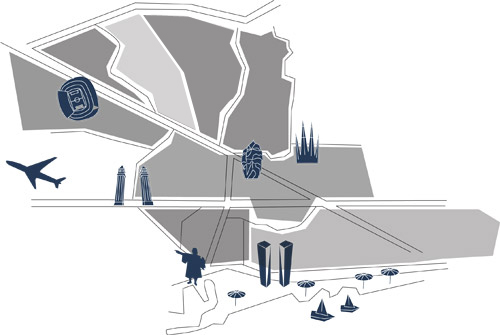Barcelona, model for holistic urban planning
Wednesday, 13 August 2014 21:03
Architect Brent Toderian explains Barcelona' success story

Spain may be facing significant economic and political challenges these days, but Barcelona's city-building remains one of the best examples in the world. Ideal for an investment in an apartment for sale in Barcelona.
Holistic planning
For Barcelona's architects, city-building is as much about the public realm, of "civitas" or the public life well lived, as it is about buildings. This might stem from the continued reverence for Ildefons Cerdà, who functioned as city planner, architect, even health specialist - in other words, as a holistic city-builder. Due to this reverence the city has quite a holistic urban planning as a result.
Strong powerful patterns rule
Regulations or requirements do not have to constrain architectural creativity. Look at Barcelona's Passeig de Gracia boulevard. Like other beautiful streets that regulate their height, street width and other pattern-makers (Paris' Avenue des Champs-Elysees), strong powerful patterns still allow for great architectural beauty and nuance.
Make walking (and biking) irresistible
Walking has long been a priority in Barcelona - as illustrated by five centuries of “rambling” on La Rambla, one of the best people streets in the world. Cerda's l’Eixample (Expansion) plan made walking enjoyable almost everywhere - 50 percent of all street space is dedicated to walking space, with the other 50 percent for all other forms of 'traffic.'
Urban biking is growing fast in Barcelona, spurred on by the locals-only bikeshare system, and very simple bike-lane approaches (some separated, some not) to improve bike safety. When the city has incorporated separated bike-lanes, it’s taken from the 50 percent that's for the rest of traffic, not from the walking half.
Sense of scale done right
A city does not have to be build just for cars and trucks; it works just wonders to have small, tight streets combines with properly designed wide streets for a great urban experience that creates a sense of scale. Barcelona reminds us that the values and choices that shape streets, and the design details, can matter more than the specific width.
Tall buildings can be placed properly
Barcelona shows the important question isn't if, but where. The key is to pick the smart locations for height, and to demand a beautiful building and public realm interface. Don't let a starchitect or flashy design dazzle you into putting tall buildings in the wrong places.
Barcelona makes mistakes too
Barcelona isn't perfect. Some public spaces seem designed for architectural magazines, and are empty of people. Many recent buildings seem like flashy objects in space, with unsuccessful scale and dead spaces surrounding them. Even where Barcelona is less successful though, it stimulates great discussions. Generally, however, the city is still an urbanism success story constantly in the making!




